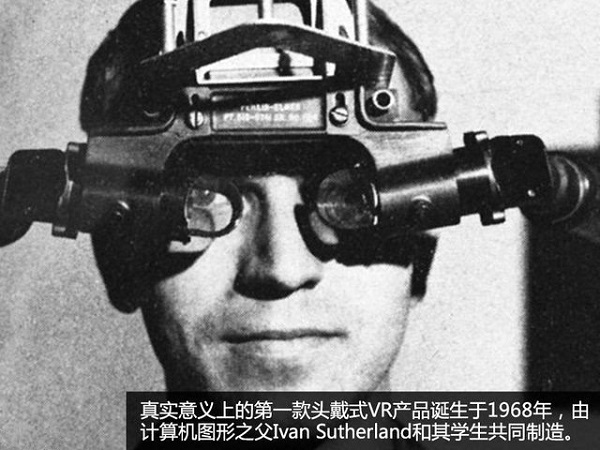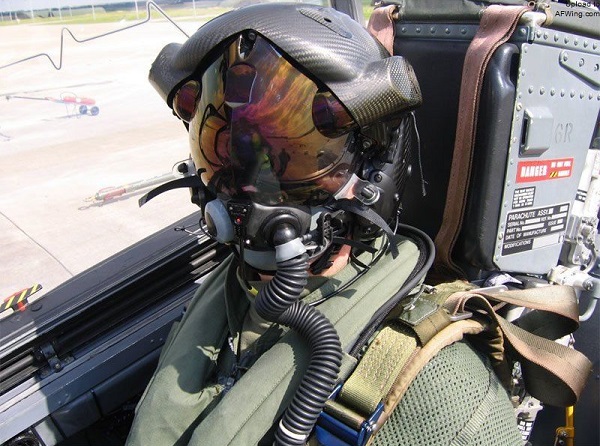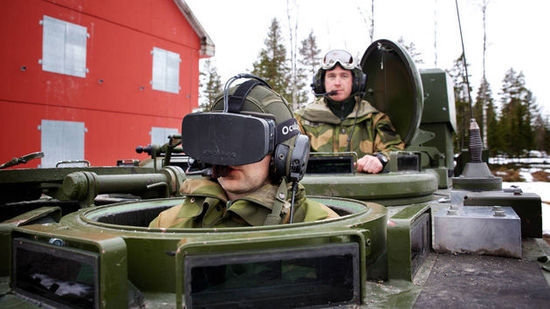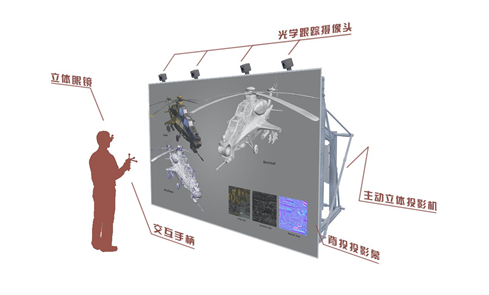If we say that VR (virtual reality) has great prospects for video, games, education and other fields. Then, the military field is a practical field of VR. Turning over the history of its development, the earliest VR technology is even a purely military technology.

The application of VR technology in military has been carried out for several decades
While everyone was still lamenting the magic of VR headlines, half a century ago, in 1968, the world’s first helmet-mounted display, the monitor of the Damocles Sword helmet developed by Ivan Sutherland, director of the US ARPA Information Processing Technology Office, Is a military helmet display.

Military technology generally leads civil technology for 10-20 years
As we all know, war is an important factor in promoting the development of science and technology. In a broad sense, VR covers a wide range of content, but in the early stages, it was developed as a technical branch of the fighter helmet system.
Of course, because the driver needs to take care of the complex equipment in the operating cabin, it is impossible to completely close the vision like the common VR devices nowadays. Therefore, VR is only a branch technology for a new generation of fighter heads. It also includes the integration of various technologies such as Pingxian, head tracking, and eye tracking. These technologies have only slowly appeared in the civil domain of VR until recently.

In the cutting-edge field, the F35 HMDS helmet system of the five-generation machine can directly display 360-degree panoramic images around the outside of the aircraft. The line of sight will not be disturbed by the fighter itself, and even a certain MR (mixed reality) technology can be applied. And its unit price of 400,000 US dollars equivalent to more than 2.4 million yuan also makes it the "most expensive head-display equipment," but such a high cost is only a fraction of the single-frame purchase cost of the F35 more than 135 million US dollars.
The advantages of VR technology in military applications
The scope of application of VR technology in the military field is quite extensive, and its advantages are mainly concentrated in two aspects.
Training cost
The most common application of VR in military is simulation training. The biggest advantage is that it can save training costs, or take the Air Force as an example.
The life span of modern fighter aircraft is about 1,000 times, plus the cost of fuel, ground handling, maintenance, fighter costs, etc. The cost of real aircraft flight training is extremely expensive. L-15's chief teacher once said that the training cost for a Su-27UB and Su-30 is one to five thousand US dollars, which is between 260,000 yuan and 33 million yuan.

The use of virtual reality technology to conduct fighter simulation training will undoubtedly greatly save training costs. In fact, the U.S. military started this research very early. In the 1980s, the VASA was started by the U.S. Air Force to study the vision-coupled aviation simulator (VCASS) program. It is to use heads to simulate the realistic cabin environment and to be able to pilot the simulation system. The system of action to react.
With advances in technology, training cockpits with full-motion equipment are not uncommon, and there have even been simulation training cockpits that use centrifugal equipment to simulate high-overload environments. Both head-mounted cockpit simulators and panoramic cockpit simulators have their own training and positioning. These equipments are difficult to popularize in the civilian market because of hundreds of thousands of hardware costs. However, compared with the Air Force, they have a large training cost. It is the best ground training method.

In addition to burning the money, the Air Force recently began to use the middle and low-end VR equipment for individual training in the Army. Compared to traditional training, VR can simulate a variety of battlefield environments that are difficult to deploy in real life, as well as respond to the UHP state of war and how to target and hit targets in the face of fierce enemy fire. This training method has been proved to be cheaper than the traditional training method, and the combination of the two can produce quite good results.
2. Cutting-edge technology
From the perspective of high-end military technology, VR technology makes the form of war more scientific and technological sense.
In terms of hardware, VR is also a major trend in the development of fighter planes in the future. Each renewal of fighter aircrafts is reducing the instrumentation and control equipment in the cockpit, trying to integrate all kinds of data and output information in the fighter's head display, which can reduce pilots. Repeatedly looking down at the dashboard, the driver is more focused on the actual flight. Similarly, such VR technology with full-angle information integration can also be applied to military vehicles such as tanks, armored vehicles, and warships.

With the increase of remote control technology, VR will also usher in new developments in this field.
The combined equipment of drones and VR has already appeared in the civilian market, and the greater prospect of this technology is for remote control of military equipment. As we all know, whether it is fighter jets, tanks, battleships, or submarines, designers need to accommodate space. Not only do they occupy a certain volume, but direct attacks on drivers have always been hard to avoid. This is the reason why all kinds of military drones and remote-control robots have been fully developed in recent years. The VR Headset will be the best viewing remote control platform for such devices due to its wide viewing angle and strong sense of substitution. The loss of war to combatants will then be even lower, and even change the traditional mode of war.
In this regard, the Pentagon’s National Geospatial-Intelligence Agency (NGA) has launched a development plan for the use of VR headsets and controllers to remotely control military operations. The outlook is not to be discounted.
Application of VR Technology in the Current Military Field
The practical application of virtual reality began early in the military field. The flight simulation training mentioned above had the concept of virtual reality in the early days, but the military did not deliberately emphasize VR in this application. With the warming up of the VR topic in the private market, reports on the military sector have gradually cited VR as a hotspot.
Since 2012, the US military has begun to use its own VR hardware and software for simulation training, including war, combat, and medic training. These simulations can help soldiers train in dangerous situations in a more economical way. The fully immersed "Disposed Soldier Training System" (DSTS) deployed by the United States at the Fort Bragg Virtual Training Course is the most mentioned military VR application. In addition, in Washington, DC, and Marina Del Ray, California, two "parallel labs" are using VR devices to help the Navy achieve the next generation of control interfaces. With this, future combatants will be able to drive ships with "all-dimensional awareness" or collaborate with designers thousands of miles away in real time to repair high-tech components on board.

The recent use of the Oculus Rift by the Norwegian military on tanks for driver-free blind zone environmental testing is a typical example of VR technology for military use.
In China, as early as the “863†and “973†plans, there was a preliminary study of virtual reality. After the integration, the “National Key R&D Program†has more than doubled the original R&D scale of virtual reality. At the beginning of the year, CCTV reported that the People's Liberation Army used VR technology to train paratroopers. Parachute jumpers can simulate skydiving with the first view in the virtual reality glasses. In this process, the parachutist can continuously feel and adjust the air attitude according to his real situation in the air. At the same time, the pilot can From the third perspective, it monitors the various operations of parachuters and provides timely guidance to help them master the technology better.

Later on at the 10th China International Defense Electronics Exhibition in May, leading VR companies such as China Vision and Longdifeng set up a VR experience zone in Hall 1B. VR helmets and other equipment on display can realize virtual battlefield environment and military simulation. Training, combat plan development, operational effectiveness assessment and other comprehensive experience.
In addition, countries such as the United Kingdom, Australia, the Netherlands, and Thailand have already invested in virtual reality and military-related research. It can be said that the global military community has become interested in VR very early.
From a practical point of view, perhaps the military field is the largest demander of VR technology.
Modern warfare is essentially a high-tech war. It has a deep connection with VR, an extremely versatile human-computer interaction technology. The investment and demand for VR in the military field is far more urgent than that for the civilian market. It also has the characteristics of large number of purchases, high R&D investment, and strong pertinence. The demand for VR in the military field is not only cutting-edge technology. The military has no small demand for low-end VR hardware and software. The development of a stable middle- and low-end civilian VR industry can also feed back into the military field to some extent.
A bipolar Stepper Motor has one winding per stator phase. A two phase bipolar stepper motor will have 4 leads. In a bipolar stepper we don`t have a common lead like in a uni-polar stepper motor. Hence, there is no natural reversal of current direction through the winding.
A bipolar stepper motor has easy wiring arrangement but its operation is little complex. In order to drive a bipolar stepper, we need a driver IC with an internal H bridge circuit. This is because, in order to reverse the polarity of stator poles, the current needs to be reversed. This can only be done through a H bridge.
Bipolar stepper motor,Bipolar motor,2 phase bipolar stepper motor,4 wire bipolar stepper motor,Bipolar dc motor,Bipolar stepper motor price
Shenzhen Maintex Intelligent Control Co., Ltd. , https://www.maintexmotor.com